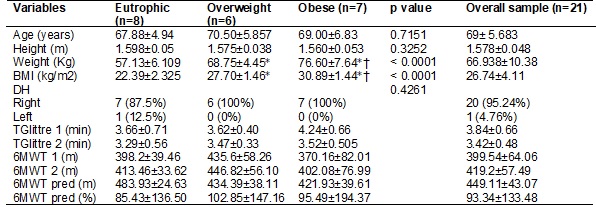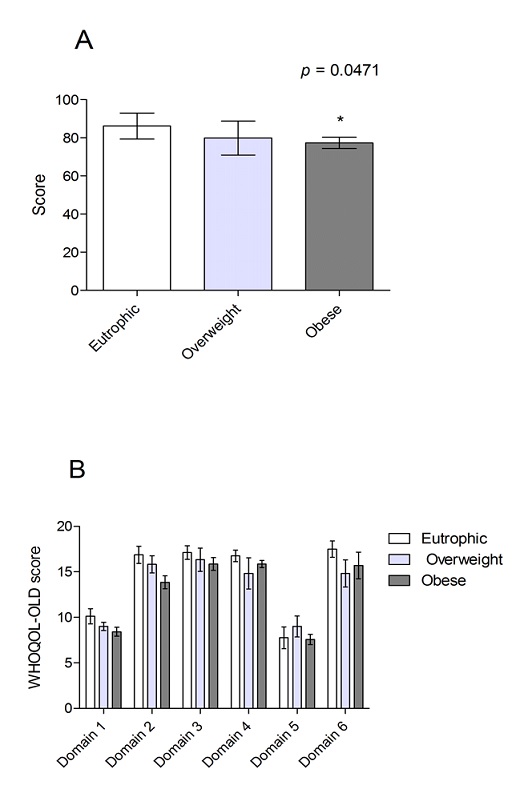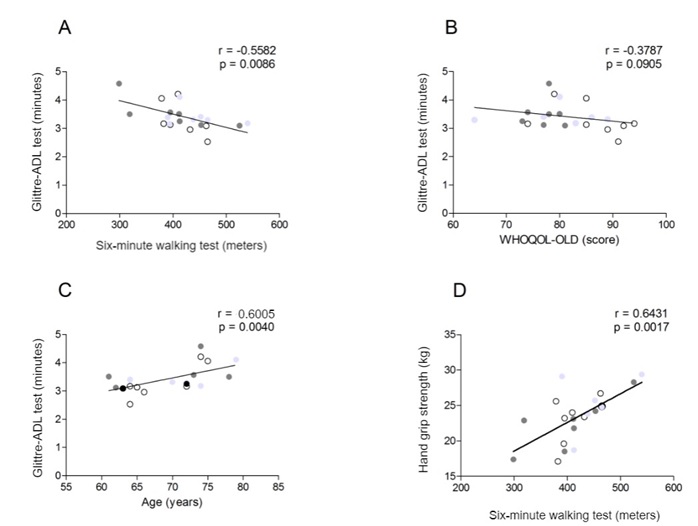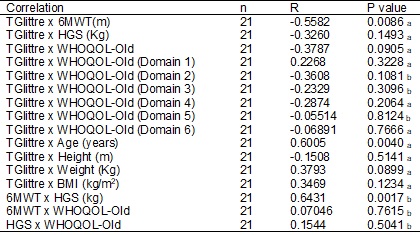ORIGINAL
ARTICLE
Glittre ADL test in eutrophic,
overweight and obese elderly
Teste de AVD-Glittre em idosas eutróficas, com
sobrepeso e obesidade
Augusto Baumhardt Guidoti, Ft.*, Ângelo
Pereira Cattani**, Cintia Laura de Araujo, D.Sc.***, Fernanda Beatriz Costa Delacoste,
Ft.*, Guilherme Scotta Hentschke,
D.Sc ******, Pedro Dal Lago, D.Sc.*****,
Vitor Scotta Hentschke, D.Sc.***, Mirele Ruff Trojahn, M.Sc.***
*Aluno de Mestrado
Acadêmico, Universidade Federal de Ciências da Saúde de Porto Alegre (UFCSPA),
Porto Alegre/RS, **Acadêmico do Curso de Fisioterapia, Universidade Luterana do
Brasil (ULBRA), Cachoeira do Sul/RS, ***Professor na Universidade Luterana do
Brasil, Campus Cachoeira do Sul (ULBRA), Cachoeira do Sul/RS,****Aluna de
Pós-Doutorado, Katholieke Universiteit
Leuven, Bélgica, *****Professor na Universidade
Federal de Ciências da Saúde de Porto Alegre (UFCSPA), Porto Alegre/RS ,
******Aluno de Pós-Doutorado, Centro Interdisciplinar de Investigação Marinha e
Ambiental (CIIMAR), Matosinhos, Portugal
Received: October
23, 2019; accepted: December
10, 2019.
Corresponding author: Mirele
Ruff Trojahn, Universidade
Luterana do Brasil, Unidade Universitária de Cachoeira do Sul, Rua Martinho
Lutero 96501595 Cachoeira do Sul RS
Mirele Ruff Trojahn:
mireletrojahn@hotmail.com
Dr.Vitor
Scotta Hentschke, E-mail:
vitorscotta@gmail.com
Augusto Baumhardt Guidoti, E-mail:
augustoguidoti@hotmail.com
Ângelo Pereira Cattani1,
E-mail: angelocattani@outlook.com
Dr. Cintia Laura de Araujo, E-mail: cintia_lpa@outlook.com
Fernanda Beatriz Costa Delacoste, E-mail: fernandadelacoste@hotmail.com
Dr. Pedro Dal Lago,
E-mail: pdallago66@gmail.com.
Dr.
Guilherme Scotta Hentschke,
E-mail: guilherme.scotta@gmail.com
Abstract
The
Glittre ADL-test (TGlittre)
has been designed and validated to measure functional capacity during daily
living activities in patients with chronic obstructive pulmonary disease (COPD)
but is now used in several other situations. The aim of this study was to
evaluate the applicability of TGlittre in a sample of
overweight and obese eutrophic elderly. This was an experimental and
cross-sectional study, which included 21 elderly women, allocated by BMI, in
eutrophic (n = 8), overweight (n = 6) and obese (n = 7) groups. They were
assessed for functional capacity (TGlittre and 6MWT),
quality of life (QOL) with the questionnaire World Health Organization Quality
of Life for Older People (WHOQOL-OLD) and handgrip strength (HGS). TGlittre correlated with age (p = 0.0040) and with 6MWT (p
= 0.0086), but no statistical difference was found in TGlittre's
performance time and the distance covered in 6MWT between groups. TGlittre did not correlate with HGS (p = 0.1493) and
WHOQOL-Old (p = 0.0905). The data obtained in the present study corroborate
that TGlittre is used as a functional measurement
variable in the elderly population.
Keywords: aged, obesity, exercise intolerance.
Resumo
O teste de AVD-Glittre (TGlittre) foi elaborado
e validado para mensuração da capacidade funcional durante realização de
atividades de vida diária, em pacientes com doença pulmonar obstrutiva crônica
(DPOC), porém vem sendo utilizado em diversas outras populações. O objetivo do
estudo foi averiguar a aplicabilidade através do TGlittre
em uma amostra de indivíduos idosos eutróficos, com
sobrepeso e obesidade. Trata-se de um estudo experimental e transversal, no
qual foram avaliadas 21 idosas, alocadas por IMC, nos grupos eutrófico (n = 8), sobrepeso (n = 6) e obeso (n = 7). Foram
avaliados entre os grupos a capacidade funcional (TGlittre
e TC6min), qualidade de vida (QV) através do questionário World Health Organization Quality of Life - Old Group
(WHOQOL-OLD) e força de preensão manual (FPM). O TGlittre
apresentou correlação com a idade dos participantes (p = 0,0040) e com o TC6min
(p = 0,0086), entretanto não foi encontrada diferença estatística no tempo de
execução do TGlittre e na distância percorrida no
TC6min entre os grupos. O TGlittre não se
correlacionou com a FPM (p = 0,1493) e com o WHOQOL-Old
(p = 0,0905). Os dados obtidos no presente estudo corroboram para que o TGlittre seja utilizado como uma variável de medida
funcional na população idosa.
Palavras-chave: idoso, obesidade,
tolerância ao exercício.
Introduction
The elderly population is directly affected by aging, which induce
adaptations in the neuromuscular system, cardiorespiratory and metabolic
changes [1]. Often these changes culminate in body weight gain, and obesity has
been linked to impaired functional capacity and reduced activities of daily
living (ADLs) performance, which consequently is one of the causes of physical
inactivity and sedentary lifestyle, especially in the elderly [2,3]. Thus,
there is a constant concern regarding obesity as a public health problem, as
approximately 2.8 million people worldwide die annually due to their
comorbidities [4].
For the clinical assessment of the functional status of an individual,
functional tests that are already validated and reliable are constantly
performed, including the sit-to-stand test and the six-minute walking test
(6MWT) [5,6]. Handgrip strength (HGS) is another reliable clinical method for
estimating the overall strength status and functional performance of the
elderly, being closely related to ADLs [7]. Studies show that HGS correlates
moderately with performance in specific tasks and can be a good predictor for
functional capacity [8].
The Glittre ADL-test (TGlittre)
is a submaximal test that includes the function of the upper limbs in
performing ADLs to assess functional capacity, designed initially for patients
with chronic obstructive pulmonary disease (COPD) [9]. Studies show that TGlittre is a useful and applicable tool both in adults and
children, as well as in individuals with COPD, heart failure, heart disease, in
obese adults and after bariatric surgery [10–14].
So far, TGlittre has not been performed in an
elderly eutrophic population, with overweight and obesity. Thus, the objective
of the present study was to assess the functional capacity with TGlittre in a sample of eutrophic, overweight and obese
elderly women, and to investigate the correlation with the 6MWT, HGS, and QOL.
Methods
This is a cross-sectional study, in which included elderly women (aged
between 60 to 85 years), with controlled systemic arterial hypertension (SAH),
who were sedentary (individuals who perform less than 30 minutes of moderate
physical activity daily during most days of the week), who completed the
proposed assessments and who signed the informed consent form. The volunteers
were recruited from August 2017 to April 2018, in groups of elderly people from
a city in the countryside of Rio Grande do Sul, Brazil. The study was approved
by the Human Research Ethics Committee, of the Lutheran University of Brazil,
campus Canoas/RS, protocol number 3.452.176.
Women were excluded when they had physical disabilities (amputations of
upper and lower limbs, blindness), trauma-orthopedic injuries (bone fractures
or muscle injuries in the last 6 months), cognitive impairments, neurological
disorders (Alzheimer's, Parkinson's, vestibular disorders and dementia), use of
walking aids and orthoses, gait changes and limb discrepancy. As shown in the
diagram in figure 1, the chronological order of data collection can be
observed.
First, a previous assessment was carried out to collect sociodemographic
and anthropometric data [gender, age, ethnicity, hand dominance/preference,
body weight, height and body mass index (BMI)] and then the TGlittre
was performed. On the second day, within the same week, the 6MWT was performed
both functional tests were performed twice, with a 30-minute rest interval
between assessments, and the best result between the two measures was used, due
to possible learning effect. During the interval between the two TGlittre, a QOL questionnaire was applied, specifically for
the elderly population (WHOQOL-Old) [15].

HGS
= Hand Grip Strength; DH = dominant hand; NDH = non-dominant hand; WHOQOL-Old =
World Health Organization Quality of Life for Older People.
Figure
1 - Study Protocol.
For the assessment of the HGS, a digital dynamometer was used (apparatus
brand - Camry®, model EH 101-37, with a maximum capacity of 90 kg and a scale
of 1 g). The patient was positioned sitting in a chair with an upright spine,
maintaining a degree of knee flexion at 90, shoulder in adduction and neutral
rotation, elbow flexed at 90°, forearm and wrist in neutral position, arm kept
suspended in the air with the hand positioned on the dynamometer, the hand was
supported by the evaluator. For all subjects, the dynamometer handle was
individually adjusted, according to the size of the hands it was considered the
highest measurement among the three measures in the dominant hand (DH) or in the
non-hand dominant (NDH). There was a rest period of 60 seconds between
measurements, with alternating measurements between DH and NDH. The
participants performed a warm-up in the form of a submaximal grip while the
procedure was explained. The volunteers performed the grip during expiration,
without performing Valsalva maneuver, in addition to being verbally stimulated
during the test [6,16].
Glittre-ADL test (TGlittre)
The circuit was designed according to the standard protocol, its
representation is shown in figure 2. For the test, a chair, a staircase and an
adjustable shelf with surfaces at the shoulder and waist height were used. The
individuals carried a backpack (weight 2.5 kg) and followed a circuit with the
following activities: from the sitting position, the individual walked on a
10-meter-long flat aisle, interposed in half by a staircase with two steps up
and two steps down (17 cm high x 27 cm wide). After completing the second half,
the patient moved three 1 kg-objects from a shelf at shoulder height to another
at waist height and then to the floor. From there, they returned with the
objects from the floor to the waist-high shelf and finally to the top shelf.
After that, the participant went through the circuit again, crossing the steps,
until reaching the starting point (chair). The participant sat down and
immediately started the next lap. If the subject wanted to take a pause, the
pause duration would be timed and added to the time to complete the test. The
individuals were instructed to complete five laps as fast as possible. Heart
rate (HR), peripheral oxygen saturation (SpO2) and dyspnea and leg fatigue
assessed by the BORG scale were monitored at each lap. No verbal stimulus was
made during the test [9].

Source:
Skumlien S et al. [9].
Figure
2 - Representation for the performance of TGlittre (Standard Protocol).
.
Six-Minute
Walking Test (6MWT)
The 6MWT was performed according to the guidelines of the American
Thoracic Society [17]. For its realization it was necessary a flat surface of
30 meters, being demarcated in every meter. The individuals were instructed to
walk as far as possible and they receive standardized verbal encouragement. HR,
SpO2 and the dyspnea and leg fatigue (Borg scale) were measured at the
beginning, in the 2nd and 4th minutes and at the end of the test. For analysis,
the longest distance covered was considered [10].
Quality
of Life for Older Persons (WHOQOL-OLD)
The quality of life was measured with a specific and validated
questionnaire, called the World Health Organization Quality of Life for Older
People (WHOQOL-OLD). This evaluation tool consists of 24 questions and its
answers follow the Likert ordinal scale of 5 points (from 1 to 5). They are
divided into six domains: sensory functioning, autonomy, past, present, and
future activities, social participation, death and dying and intimacy [15].
Statistical
analysis
Data are expressed as means ± SD for each variable and group. The
Shapiro-Wilk test was performed to assess the normality of all variables. One-way ANOVA, followed by the Student Newman-Keuls post hoc test was used to compare parametric data
between groups. The Kruskal-Wallis test, followed by Dunn's post hoc multiple
comparison test, was used to compare nonparametric data between groups. Pearson
and Spearman's correlation test was used to investigate the relationships
between parametric and nonparametric data. A value of P < 0.05 was considered
statistically significant. GraphPad Prism 5 (Graph-Pad Software, San Diego, CA,
USA) was used in data analysis and graph creation.
Results
21 elderly women were included, aged between 62 and 79 years. Among 37
individuals, 13 did not meet the inclusion criteria and 3 did not complete the
proposed assessment, so they were excluded. According to the BMI criteria
proposed by the World Health Organization (WHO), following the classification
for the general population, considering the BMI: 18.5 kg/m² as underweight; eutrophy, BMI between 18.5 kg/m² and 24.9 kg/m²;
overweight, BMI between 25 kg/m² and 29.9 kg/m²; class I obesity, BMI between
30 kg/m² and 34.9 kg/m²; class II obesity, BMI between 35 kg/m² and 39.9 kg/m²
(18). From these classifications, the elderly women were divided into three
groups: eutrophic (n = 8), overweight (n = 6) and obese (n = 7). Table I
presents the characteristics of the patients and groups.
Table
I - Sociodemographic and functional characteristics
of the participants.

m
= meters; kg = kilograms; min = minutes; pred (%) =
percentage of predicted; DH = dominant hand. Values presented with means ± SD.
Statistical analysis: one-way ANOVA followed by Newman-Keuls
post hoc test. Symbols represent the comparison between groups by post hoc
analysis: † P <0.05 compared to the Eutrophic group, and † P <0.05
compared to the overweight group.
Hand
grip strength (HGS)
There was no difference in HGS between the eutrophic groups: 23.06 ±
3.198 kg; overweight: 25.25 ± 3.936 kg; obese: 22.31 ± 3.696 kg; p = 0.3331.
Glittre-ADL test (TGlittre)
Table II indicates the TGlittre values in
eutrophic, overweight, obesity and general test values. There was no
significant difference between groups.
Table
II - TGlittre
(minutes) in eutrophic elderly women, overweight and obese.

Statistical
analysis (p-value): Kruskal-Wallis Test between eutrophic elderly women,
overweight and obese.
Six-Minute
Walking Test (6MWT)
There was no significant difference between groups in the 6MWT
(eutrophic: 414.9 ± 34.44 m; overweight: 449.7 ± 51.90 m; obese: 402.1 ± 77 m;
p = 0.3206).
Quality
of Life (QOL)
Figure 3A shows the WHOQOL-old values in eutrophic elderly women, with
overweight and obesity. Obese elderly women had a lower QOL score when compared
to the euthrophic group (77.29 ± 2.928 vs. 86.13 ±
6.854; p <0.05). There were no significant differences between overweight
and other groups. Figure 3B shows the QOL values in each domain of the
WHOQOL-Old questionnaire. Despite a trend of significance in domain 2 (p =
0.0668), no significant differences were observed between groups in each
domain.

Figure
3 - WHOQOL-old values in eutrophic elderly women, with
overweight and obesity.
Correlation
between TGlittre and 6MWT, quality of life, hand grip
strength and age
TGlittre
showed a significant correlation with the 6MWT (Spearman r = -0.5582; p =
0.0086; figure 4A) and age (Spearman r = 0.6005; p = 0.0040; figure 4C). The
6MWT was significantly correlated with HGS (Pearson r = 0.6431; p = 0.0017;
figure 4D). TGlittre did not correlate with QOL
(WHOQOL-Old) (Spearman r = -0.3787; p = 0.0905; figure 4B). Table III
summarizes all the correlations carried out in this study. Figure 4 highlights
the correlation between TGlittre and 6MWT; TGlittre and QOL; TGlittre and
age; 6MWT and HGS.


Figure
4 - Correlations between TGlittre
with 6MWT, QOL, age and HGS.
Table
III - Correlations between TGlittre
with quality of life, 6MWT and anthropometric variables.

a
= Spearman’s correlation; b = Pearson's correlation; TGlittre
= Glittre-ADL test; 6MWT = 6-minute walking test; HGS
= hand grip strength; WHOQOL-Old = World Health Organization Quality of Life
for Older People; BMI = body mass index.
Discussion
The present study investigated the functional capacity assessed with TGlittre in a sample of eutrophic elderly, overweight and
obesity classes I and II. To our knowledge, this is the first study to propose
the application of TGlittre for the elderly
population with this profile, as well as to verify its executability. The TGlittre correlated with the age of the participants and
with the 6MWT, however, there was no significant difference in the time of
execution of the TGlittre and in the distance covered
in the 6MWT between the groups. TGlittre did not
correlate with HGS and WHOQOL-Old when the QOL of life was compared between
groups, the obese group had a lower score.
In a recent study, TGlittre was valid and
reproducible to assess functional capacity in a group of obese individuals (n =
21), aged 44 ± 9 years and with BMI of 44 ± 6 kg/m2 [12]. In the present study,
no significant difference was found between the three groups, having as
possible cause the sample size, the difference in age (69.0 ± 6.83 years) and
BMI (30.89 ± 1.43 kg/m2). As for TGlittre
and its correlation with age (r = 0.6005; p = 0.0040), it is observed that the
older the age, possibly the lower its performance on the test. A recent study
carried out with a group of elderly people with COPD, corroborates our
findings, as the time spent on TGlittre was also
associated with age (r = 0.66, p = 0.03) [10].
One study found a moderate to the high correlation of TGlittre with 10m walking tests with and without a load in
obese patients and post-bariatric surgery [12]. Other studies, including COPD
patients, support these findings, identifying an association between the time
of TGlittre performance and the distance covered in
the 6MWT [9,10]. In the present study, a moderate correlation was observed
between TGlittre and the 6MWT (r = -0.5582, p = 0.0086),
showing that TGlittre is an indicator of functional
performance in elderly women, since demonstrating a certain equivalence with
the 6MWT, considered the gold standard submaximal test so far.
HGS was evaluated for possible correlations with TGlittre,
due to studies presenting it as a good predictor for performance in motor tasks
in frail elderly people in functional tests, such as in the 10-meter walk test
at maximum speed (C10) and Timed Up & Go Test (TUG) [8]. There were no
significant differences between the experimental groups in the HGS nor in the
correlation with the TGlittre (r = -0.3260; p =
0.1493). However, we found a correlation between the HGS and the 6MWT. In
previous studies, a significant and positive correlation of HGS with the distance
covered in the 6MWT has been shown, especially in patients with COPD. In
healthy elderly people, HGS was identified as a determinant of the total
distance covered in the 6MWT [18,19].
Regarding QOL, a recent research showed that the obese group had a lower
score in all aspects of the SF-36 questionnaire (physical and mental domains)
when compared to the post-bariatric and control group [20]. Another study also
using SF-36, found a considerable impairment in the QOL of obese individuals
[21]. A similar aspect was found in the present study since the obese elderly
women presented a lower score in the WHOQOL-Old compared to the eutrophic
subgroup (77.29 ± 2.928 vs. 86.13 ± 6.854; p < 0.05). Despite its proximity,
TGlittre did not correlate between the WHOQOL-Old
domains, perhaps revealing that TGlittre is not an
indicator for QOL in this population. Still, further studies, with larger
sample, are needed to confirm that.
This
study has some limitations. The first is the reduced sample size, considering
that there was a sample calculation that predicted at least 11 participants in
each group. It was difficult to include individuals using the established
criteria, as most of the elderly population has several associated
comorbidities. In this context, reduced samples can generate low statistical
power for associations (type II error). The second limitation was the
exclusivity of women in the population studied, the absence of males prevented
a more global analysis for the exposure of the results.
Conclusion
No difference was found between eutrophic, overweight and with obesity
grade I and II elderly women in functional capacity assessed by the TGlittre. However, relevant associations were observed
between variables, such as the correlation of TGlittre
with age and 6MWT. Still, we suggested that new studies be carried out with a
larger sample number to validate TGlittre in this
population. The data obtained in the present study corroborate that TGlittre is used as a functional measurement variable, as
well as the 6MWT, for possible interventions in the elderly population.
References
- Raso V, Cassilhas RC, Santana MG de, Boscolo RA, Viana VAR, Grassmann
V et al. Predictors of muscle strength in older individuals.
Medical Express 2016;3. https://doi.org/10.5935/MedicalExpress.2016.03.09
- Onofre T, Carlos R,
Oliver N, Felismino A, Fialho D, Corte R, et al. Effects of a physical activity program on cardiorespiratory fitness and
pulmonary function in obese women after bariatric surgery: a pilot study.
Obesity Surgery 2017;27:2026-33.
https://10.1007/s11695-017-2584-y
- Wojzischke J, Diekmann
R, Bauer JM. Adipositas im
alter und ihre bedeutung für funktionalität und frailty. Zeitschrift fur Gerontologie und Geriatrie 2016;49:573–80.
https://doi.org/10.1007/s00391-016-1133-y
- WHO. Noncommunicable diseases country
profiles 2014 [Internet]. Available from: http://www.who.int/nmh/countries/en/
- Ferrazza AM, Martolini D, Valli G, Palange P.
Cardiopulmonary exercise testing in the functional and prognostic evaluation of
patients with pulmonary diseases. Respiration 2009;77(1):3-17.
https://doi.org/10.1159/000186694
- Downs
CA. Functional assessment of chronic obstructive pulmonary disease. J Am Acad Nurse Pract 2011;23:161–7.
https://doi.org/10.1111/j.1745-7599.2011.00602.x
- Eichinger FLF, Soares AV,
Carvalho JM, Maldaner GA, Domenech
SC, Borges NG. Força de preensão palmar e sua relação com parâmetros
antropométricos. Cad Ter Ocup
UFSCar 2015;23(3):525-32. https://doi.org/10.4322/0104-4931.ctoA0610
- Geraldes AAR, Oliveira
ARM, Albuquerque RB, Carvalho JM, Farinatti PDT. A
força de preensão manual é boa preditora do desempenho funcional de idosos
frágeis: Um estudo correlacional múltiplo. Rev
Bras Med Esporte 2008;14(1):12–6.
https://doi.org/10.1590/S1517-86922008000100002
- Skumlien S, Hagelund
T, Bjørtuft Ø, Ryg MS. A
field test of functional status as performance of activities of daily living in
COPD patients. Resp Med 2006;100:316–23.
https://doi.org/10.1016/j.rmed.2005.04.022
- Corrêa KS, Karloh
M, Martins LQ, Santos K, Mayer AF. O teste de AVD-Glittre
é capaz de diferenciar a capacidade funcional de indivíduos com DPOC da de
saudáveis? Rev Bras Fisioter 2011;15:467-73.
https://doi.org/10.1590/S1413-35552011005000034
- Lage MC, Coelho GR,
Ribeiro GA, Samora, Dayane Montemezzo, Marcelo
Velloso DAGP. Glittre-adl test: a proposal for functional evaluation in heart failure. J Respir
Cardiovasc Phys Ther 2014;2(1)30-1.
- Monteiro
F, Ponce DAN, Silva H, Carrilho AF, Pitta F. Validity
and reproducibility of the Glittre ADL-test in obese
and post-bariatric surgery patients. Obes Surg 2017;27:110-4. https://doi.org/10.1007/s11695-016-2244-7
- Martins
R, Assumpção MS, Bobbio TG,
Mayer AF, Schivinski C. The validity and reliability
of the ADL-Glittre test for children. Physiother Theory Pract 2019;35:773-80.
https://doi.org/10.1080/09593985.2018.1457747
- Fernandes-Andrade
AA, Britto RR, Soares DCM, Velloso M, Pereira DAG.
Evaluation of the Glittre-ADL test as an instrument
for classifying functional capacity of individuals with cardiovascular diseases.
Braz J Phys Ther 2017;21:321-8. https://doi.org/10.1016/j.bjpt.2017.06.001
- Fleck
MP, Chachamovich E, Trentini
C. Development and validation of the Portuguese version of the WHOQOL-OLD
module. Rev Saúde Pública 2006;40:785-91.
https://doi.org/10.1590/S0034-89102006000600007
- Crapo RO, Casaburi R, Coates AL, Enright
PL, MacIntyre NR, McKay RT
et al. ATS statement: Guidelines for the six-minute walk
test. Am J Respir Critical Care Med 2002;166(1):111-7.
https://doi.org/10.1164/ajrccm.166.1.at1102
- Dourado VZ, Vidotto MC, Guerra RLF. Equações de referência para os
testes de caminhada de campo em adultos saudáveis. J Bras
Pneumol 2011;37:607-14.
https://doi.org/10.1590/S1806-37132011000500007
- Enright PL, McBurnie MA, Bittner V, Tracy RP,
McNamara R, Arnold A, et al. The
6-min walk test: A quick measure of functional status in elderly adults. Chest 2003;123:387-98.
https://doi.org/10.1378/chest.123.2.387
- Monteiro F, Ponce DAN,
Silva H, Pitta F, Carrilho AJF. Physical function,
quality of life, and energy expenditure during activities of daily living in
obese, post-bariatric surgery, and healthy subjects. Obes Surg
2017;27:2138-44.
https://doi.org/10.1007/s11695-017-2619-4
- Tamura LS, Cazzo E, Chaim EA, Piedade SR. Influence of morbid obesity on physical capacity, knee-related symptoms
and overall quality of life: A cross-sectional study. Rev Assoc
Med Bras 2017;63:142-7.
https://doi.org/10.1590/1806-9282.63.02.142